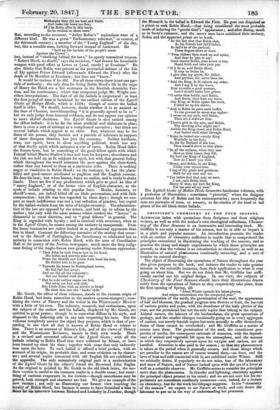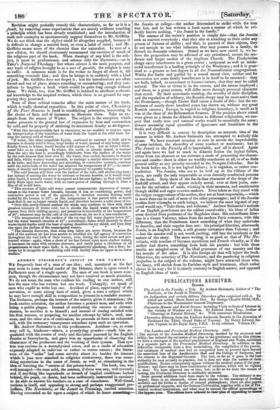GRIFFITHS'S CHEMISTRY OF THE FOUR SEASONS. ALTHOUGH laden with quotations
from Scripture and from religious writers, as well as with the author's own theological reflections, Chemis- try of the Four Seasons is an instructive and interesting book. Mr. Griffiths is not only a master of his science, but he is able to impart it in a plain and popular manner. An introduction presents the reader with an outline of chemistry sufficient to enable him to comprehend the principles enunciated in illustrating the working of the seasons, and to practise the cheap and simple experiments by which those principles are proved; so that the volume is an introduction to chemistry, as well as an illustration of natural phasnomena continually occurring, and a sort of treatise on natural theology.
The object of illustrating the operations of Nature throughout the year also gives purpose to the book, and induces the reader to take greater interest in the scientific instances, from their application to what is ever going on about him. But we do not think that Mr. Griffiths has suffi- ciently carried out his original design. In our view, the subjects of Chemistry of the Four Seasons should have their illustrations drawn solely from the operations of Nature as they respectively take place, from the first opening of Spring, till
"dread Winter spreads his latest gloomy, And reigns tremendous o'er the conquered year."
The preparation of the earth, the germination of the seed, the appearance of leaf and blossom, the gradual progress into flowers or fruit, the harvest of various grains and pulse, with the decadence of the leafy glories of the year, are the prominent but not the only topics that belong to the subject. Animal nature, the labours of the husbandman, the great operations of geology, and the smaller changes continually going on in every aggregate of matter, not merely furnish topics but seem actually to offer themselves. Some of these cannot be overlooked ; and Mr. Griffiths as a matter of course uses them. The germination of the seed, the constituent pro- perties of earths, the consequent rationale of manures, with the depend- ence of animal and vegetable life upon the atmosphere, and the manner in which they respectively operate upon its oxygen and carbon, are all handled. Attention is also paid to the season ; so that any phenomenon is taken at the period when it generally occurs, and those things which are peculiar to the season are of course treated then,—as frost, and the laws of heat and cold connected with it, are exhibited under Winter. Still we critically desire, if popularly we do not miss, less of the laboratory and more of Nature, and of Nature looked upon with the eye of a lover as well as a scientific observer. Mr. Griffiths seems to consider the principles more than the phs3nomena. In thunder and lightning, electricity appears the principal object present to his mind ; and we are not sure but his ex- periments are sometimes needlessly numerous—not, indeed, for a lecture on chemistry, but for the work his titlepage suggests. In the "chemistry of the seasons" we expect to see Nature at work, and only desire the laborator to put us in the way of understanding her processes. Revision might probably remedy this characteristic, so far as it is a fault, by removing some experiments that are merely evidence touching a principle which has been already established ; and the introduction of such new examples as spontaneously suggest themselves to Mr. Griffiths. We do not think that the defect could be altogether supplied, because it is difficult to change a natural bent, or even a habit of mind; and Mr. Griffiths seems more of the chemist than the naturalist. In case of a new edition, we should strenuously recommend the excision of much of the religious part of the book. When theology of any kind is the sub- ject, it must be predominant, and science only the illustrator,—as in Paley's Natural Theology: but where science is the main purpose, and any topic of religion brought in as a sort of garnish, the religion is sure to suffer. A common mode is for the writer to forget all about it, till something reminds him; and then he brings it in suddenly with a kind of jerk. Mr. Griffiths does not forget it, but his introductions are often forced and out of place, always retarding or encumbering; and they con- tribute to lengthen a book which would be quite long enough without them. We think, too, that Mr. Griffith is induced to attribute a chemi- cal knowledge to the inspired writers, which there is no ground for sup- posing they possessed.
None of these critical remarks affect the main matter of the book, which is really chemical exposition. In this point of view, Chemistry of the Four Seasons is lucid in establishing principles,, interesting hi the choice of facts and of instances to illustrate them. Take an ex- ample from the season of Winter. The subject is the exception which water presents to the general law of expansion by heat and contraction by cold, and its property of attaining its maximum density at 40 degrees.
"With this incontrovertible fact in chemistry, we are enabled to venture upon an interpretation of the transition of water from the liquid to the solid state du- ring the natural cold of winter.
"If water, like other congelable liquids, continued to contract in bulk and to increase in density until it froze, large bodies of water, instead of only being super- ficially frozen in winter, would become solid masses of ice. Let us select a fresh- water lake as an example. In winter, the earth, as already stated, is warmer than the air; the heat is accordingly withdrawn from the surface of the water by the cold breezes that blow over it; the water, thus cooled, increases in density and falls, whilst wanner water ascends, to undergo a similar abstraction of heat in its turn; and the descending and ascending, or convective currents, continue until the entire bulk of the water has attained the temperature of 40°,—its maxi- mum of density and temperature perfectly congenial to aquatic beings.
"The cold breezes still blow over the surface of the lake, still abstracting heat; but instead of causing the water to contract or become heavier, as it would every other liquid, it actually causes it toexpand and become lighter; so that cold water fairly floats upon warm water, with no more power of sinking through it than a film of oil would have.
"This stratum of light cold water cannot communicate depression of tempo- ratuse.to the warmer water beneath, because it has no conducting power, and convective power is out of the question; it therefore remains floating. until cooled by the breezes to 32°; at this temperature it has.parted with so much' heat that it can no longer remain liquid, and therefore becomes a solid sheet of ice. " Over this newly-formed surface• the winds may continue to blow with their greatest intensity of winter cold; but it shields the liquid water upon which it repw.u, from their chilling agency, and preserves it immutably at the temperature of 40°, whatever may be the cold of the ambient air, for ice is a non-conductor.
"The temperature of the surface of the ice may fall many degrees below 32°, but the water beneath remains at 40°; accordingly, fishes dwell securely in these warm liquid depths until the heat of spring dissolves the icy shild, and then they rise upon the surface of the emancipated waters.
" The chemist discovers, that some deep lakes are never frozen, because the cold of the ambient air has been. unable to establish the full agency of convection throughout the vast bulk of their waters, even daring the most severe and pro- tracted winter: again, when a sheet of ice has formed upon more shallow waters, it increases its mass with extreme slowness, and rarely, gains a thickness at all proportionate to their main bulk; it is, comparatively speaking, but a film; be- cause ice is incapable of conducting cold with facility from.its upper to its lower surface."



























 Previous page
Previous page